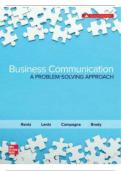,SOLUTION MANUAL FOR BUSINESS COMMUNICATION A
PROBLEM SOLVING APPROACH 2ND EDITION KATHRYN
RENTZ, PAULA LENTZ, MARCO CAMPAGNA, CARLEIGH BRADY
Chapter 1-14 and Refrence(A B)
Business Communication: A Problem-Solving Approach
Chapter 1: Solving Communication Problems in the Workplace
Teaching Suggestions
Much of the information you will cover at the beginning of the semester is routine—introduction of
yourself, office hours, course requirements, operating policies, and other business. In addition, you will
probably want to introduce the subject matter of the course. Chapter 1 contains such an introduction,
so you may want to start by summarizing its contents and adding illustrations from your knowledge and
experience. Your overall goals should be to convince the students that workplace communication is
important in business and to their personal advancement in business; to alert them to current
challenges facing business communicators; to convey basic facts about the business-communication
environment; and to bring out that business communication, as a problem-solving activity, requires
analysis, creativity, and judgment (there are no magic formulas).
If you want to add some interest to this first meeting, try assigning a message to be written in class (but
not for a grade). Make the problem a difficult one—a refusal or other bad-news situation requiring
tactful handling. Without instructions on such problems, most of the students will write messages that
are flawed. Save these messages until you cover this problem in the course and then give the messages
back. When the students see their early writing specimens and compare them with their current work,
they’ll see the progress they have made. Also, the exercise is good for a few laughs, especially if you
have some students read their original messages aloud to the class.
Another idea is to present a sample message (perhaps one from a real business) and, going over each
part in detail, discuss the many decisions that went into the writing of the message. For example, the
writer had to decide first even whether or not to write; then he/she needed to decide what genre (or
form) of message this would be, how formal to make it, how to address the reader, what to say, how to
organize the contents, where to put the paragraph breaks, which wording would be best in each place,
and so on. This exercise reinforces the key point that good business communication is good decision
making—as well as the point that preparing any message of importance will require time, care, and
revision.
Still another possibility is the “message makeover” exercise. Present a poorly written message from a
real organization, with identifying details removed. A negative message is often the most relatable and
entertaining to students. (One option is a memo announcing layoffs.) This also gives you the opportunity
to discuss the importance of choosing the correct medium for the message. Ask students what problems
they find with the tone, writing style, and information included and how they would improve these.
,Then present a well-written revision, explaining that this is the kind of writing they’ll learn how to do in
, this course. This exercise helps students become aware of how much they already know about
identifying good versus bad writing, and how much they stand to learn from the course.
Connect provides instructors with a variety of ways to customize courses, create assignments,
determine grading policies, and receive student work. One of the tools Connect offers is the ability to
select and add interactive assignments to your course.
The following McGraw-Hill tools are also available to support your business communication instruction:
SmartBook personalizes learning to individual student needs, continually adapting to pinpoint
knowledge gaps and focus learning on topics that need the most attention. With SmartBook, learning is
more productive and takes the guess work out of what to study in a no-fail environment. The result,
students are better prepared for class and coursework. For instructors, SmartBook tracks student
progress and provides insights that guide teaching strategies and advanced instruction focused on a
more dynamic class experience.
Video Capture powered by GoReact embedded in Connect makes it simple for students to record
presentations and practice their oral communication skills essential in the business world. GoReact
streamlines instructors’ ability to provide personalized skill coaching anywhere students should
demonstrate their learning. GoReact allows instructors to easily provide feedback, assign grades, and
also share recordings with other students in cases where they evaluate their peers.
Writing Assignment Plus tool delivers a learning experience that improves students’ written
communication skills and conceptual understanding with every assignment. Assign, monitor, and
provide feedback on writing more efficiently and grade assignments within McGraw-Hill Connect®.
Writing Assignment Plus gives you time-saving tools with a just-in-time basic writing and originality
checker.
Learning Objectives
LO1-1 Explain the importance of skilful communication to you and to your employer.
LO1-2 Explain the ways in which communication in the workplace is a form of problem solving.
LO1-3 Describe the communication skills that are needed in today’s workplace.
LO1-4 Define professionalism and its importance to communication in the workplace.
LO1-5 Describe the three main categories of business communication.
LO1-6 Define organizational structure and describe its influence on the organization's communication.
LO1-7 Define organizational culture and describe the main factors that influence an organization's
culture.
LO1-8 Describe the contexts for each act of communication in the workplace.
LO1-9 Describe the steps of a problem-solving approach to business communication.
Key Terms
problem solving
heuristics
verbal literacy
visual literacy
interpersonal skills




